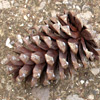Canary Island Pine (Pinus canariensis), family Pinaceae, is native and endemic to the outer Canary Islands in the Atlantic Ocean.
Pinus canariensis is a large straight evergreen tree, growing to 30-45 m tall and 1.5 m trunk diameter. The crown is usually open of regular, candelabra-like upswept branches, narrowly conic when young, widening later. The bark is very thick, scaly, fissured, patterned red-brown. Winter buds are large, cylindrical to ovoid-acute, with red-brown scales having long free tips, revolute, fringed with white hairs. A characteristic of the species is the occurrence of juvenile glaucous (bluish-green) epicormic shoots growing from the lower trunk as a consequence of fire or other damage. In fact, this pine is one of the most fire-resistant conifers in the world. The green to yellow-green leaves are needle-like, in bundles of three, 15-30 cm long, with finely toothed margins and often gracefully drooping.
Pinus canariensis cones are 10-23 cm long, ripening rich glossy chestnut-brown in April two years after pollination, and opening the same summer or up to a year later, to 9-13 cm broad. Cone scales are stout, thick, woody, and very stiff. The seeds are shiny blackish brown above, matt grey below, 11-15 × 6-7 mm with a 15-25 × 10 mm wing, buff to reddish with numerous wavy dark brown streaks; unlike most hard pines, the wing is not easily removed from the seed.
Pinus canariensis is a subtropical pine and does not tolerate low temperatures or hard frost, surviving temperatures down to about −6 to −10 °C. Within its natural area, it grows under extremely variable rainfall regimes, from less than 300 mm to several thousands, mostly due to differences in mist-capturing by the foliage. Under warm conditions, this is one of the most drought-tolerant pines, living even with less than 200 mm per year.
Pinus canariensis is a popular ornamental tree in warmer climates, such as in private gardens, public landscapes, and as street trees. It is widely planted as an ornamental and as a plantation species. In Australia and South Africa it has escaped cultivation and is actively invading (i.e., naturally regenerating) in native habitats. Reproduction is usually by seeds but the juvenile shoots root easily from cuttings.
Its aromatic wood, especially the heartwood, is among the finest of pine woods - hard, strong and durable.
Written by Amram Eshel





